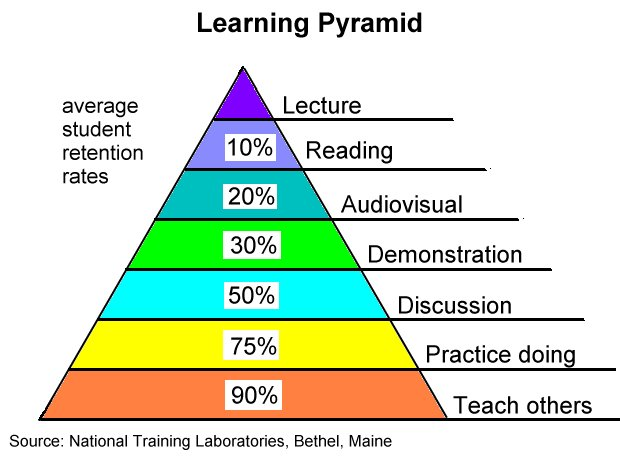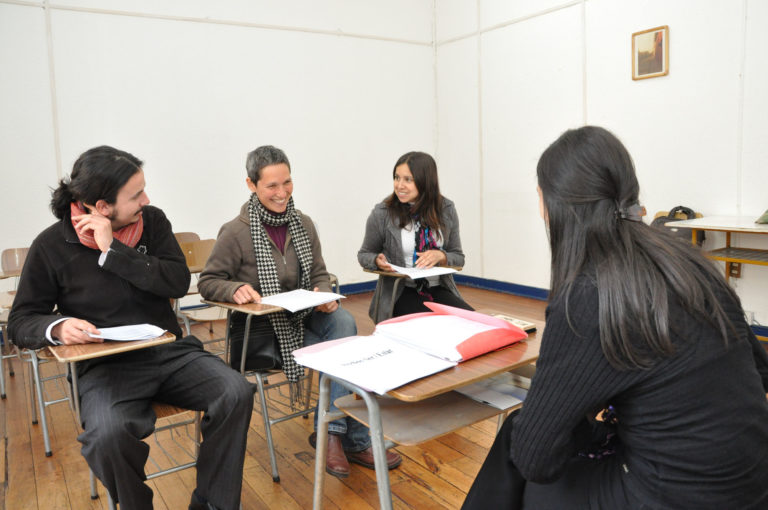How Immersion Helps You Retain The Spanish You Learn While Studying Abroad
For professionals trained in education, the learning pyramid is a familiar sight. For those of us who are on the learning side of the classroom, it may not be as familiar.
The learning pyramid is a theory that different types of educational activities can increase retention in students. You can see the pyramid below:

This learning theory is also called the "learning cone". The percentages refer to the amount of information retained by students after 2 weeks.
Although the pyramid’s assigned percentages and research are disputed by professional educators, there is validation in using a variety of teaching methods to reach each student in their preferred way of learning.
Look for these 5 approaches that Spanish immersion schools use to help you retain and build upon your Spanish knowledge, thereby rapidly propelling you toward fluency.
Approach #1: Words, Words Everywhere! (Reading)
When you study in a Spanish-speaking country, you will be reading in Spanish everywhere you turn. There will be no escaping the signs, plaques, magazines, and such; and in order to adeptly maneuver in the city you will need to be able to understand the basics.
Aside from reading the environment in which you are living, there is also reading involved during classes and in the educational materials presented. If you are a beginner, don't be discouraged - reading in Spanish will also be accompanied by instruction (see Approach #2).
Approach #2: Combining Listening and Seeing (Audiovisual)
Audiovisual learning is when you combine hearing and sight. Immersion schools do this intentionally through playing video clips in class, films as an after-school activity, but it is also as simple as the professor writing down what he or she is teaching as it is explained.
This type of learning is also amplified outside the classroom walls. Immersion learning is a powerful audiovisual tool because you will be surrounded by moving, talking locals who will stimulate your eyes and your ears! The music you hear, the people you watch and the cultural nuances you notice will secure in your brain the information you have learned in class.
Approach #3: Getting A Demo (Demonstration)
Your Spanish immersion professors will demonstrate your lesson concepts. . . multiple times! They will demonstrate the conjugation of verbs, how to form sentences, how to respond appropriately to others, and the list goes on and on. They will also oftentimes talk through their thought process as they construct ideas in Spanish, which you can then model on your own.
Demonstrations of speaking Spanish and using the local gestures and facial expressions will be everywhere. You would have to walk around blindfolded to not witness authentic interactions in Spanish, and you’ll pick up some slang and colloquialisms as you observe those around you.
For example, in Chile you’ll hear the word cachai (“got it?”), in Argentina you’ll learn vos (a form of tú), and in Peru you’ll find things that are bacán (great, cool).
Approach #4: Talk It Out (Discussion)
At a reputable, effective Spanish immersion school you will have conversations and discussions in class. In fact, many schools have a separate class just for conversation, and rightfully so! When you have the chance to have meaningful discuss in Spanish, the words and phrases you use and hear others use will be more deeply ingrained in your brain.

Group discussion during conversation class is a staple at Ecela Spanish schools. Classes are kept small and professors ensure that every student gets ample speaking time.
When conversation classes are kept small, you have no choice but to participate in the discussion. Classes of 8 or fewer students are ideal to get in as much talking as you can, and your professors will be there to listen, gently correct mistakes, and help you finish your thoughts if you get stuck.
Discussion about the actual Spanish grammar is important, but even more vital is being able to discuss everyday topics en español. When you can chat (in Spanish) with a French classmate about the best place to grab lunch or discuss world events with a Swiss classmate, you are etching those words and the grammar used in your mind for later use.
Approach #5: Práctica Hace Al Maestro – Practice Makes Perfect (Practice Doing)
Sure, you’ll get a lot of practice in your Spanish classes at your immersion school. There will be lessons, conversations, worksheets, and homework.
However, some of the most potent Spanish practice comes outside of class.
If you choose to live with a local homestay family, almost your entire day will be conducted in Spanish. You will have practice conversing about how to use the shower, when meals will be, while playing with the children of the family, and other everyday activities.
When you travel to and from school, when you participate in after-school activities, and when you embark on weekend trips, you will put your classwork into action and get that real-world training. You’ll learn about new colloquialisms, new Spanish idioms, and new accents. You’ll have specific mental images and memories to go with your Spanish knowledge, and that makes all the difference.
How Immersion Compares
Spanish immersion programs cycle through these 5 approaches to education as you spend time there learning. But how does it compare to other methods?
Traditional Classroom Learning: The traditional high school or university Spanish class provides a lot of lecture, reading, and audiovisual. With so many students in class, discussion and practice doing are saved for those who raise their hand often, or it is unmonitored speaking practice that is left up to the students.
Although oftentimes the least effective, university classes or classes through a Spanish learning center usually hold the highest price tag when broken down into cost per hour.
Self-Study Method: Self-study programs (phone apps, computer programs, etc. . . ) are a great way to fit in Spanish learning in your free time and potentially save some money, but there is only so much they can teach you.
You’ll get in a lot of reading, audiovisual learning, and some demonstration, but it’s missing the crucial feedback piece of education. You will also be speaking to a computer or phone, and it’s hard to get “lost in conversation” in Spanish while doing so.
The Immersion Choice
Which of the 5 approaches most resonates with your learning style? How could immersion learning advance your Spanish to the next level?
The amount of real practice, feedback, and stimuli you will get during an immersion program is inimitable in any other setting. The number of words, phrases, and Spanish concepts too deep to convey with a verbal translation is incalculable. Beyond those, you will return home with an incomparable experience on which to base any further Spanish language learning.